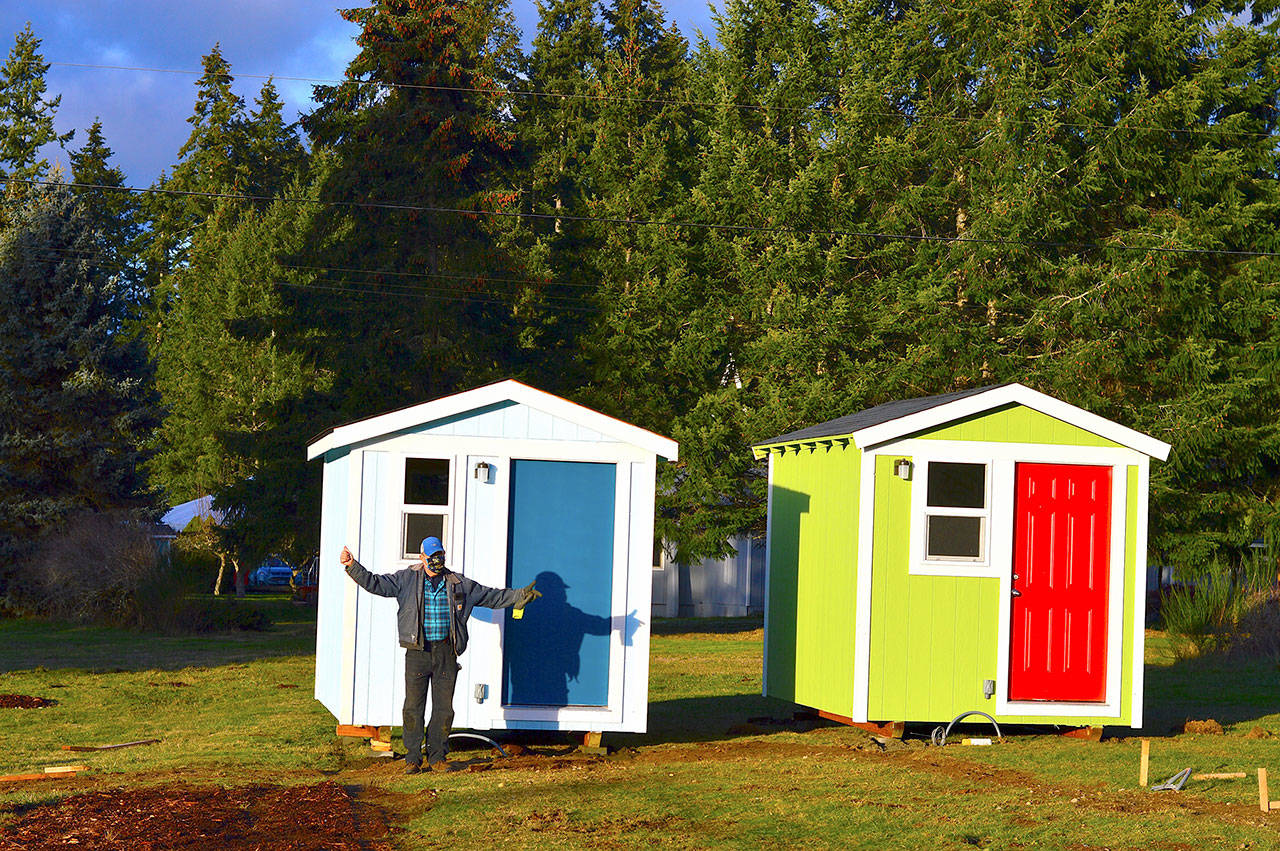PORT TOWNSEND — Emergency and serendipity. The two forces collided, then built a new kind of village.
The emergency, said Bayside Housing Services acting director Gary Keister, is the more than 150 people on his waiting list for shelter as winter sets in.
With only 26 rooms at Bayside’s Inn at the Old Alcohol Plant, that list has lengthened in recent months.
The serendipitous events look like a line of dominoes, except they’re not falling down. One by one, they’ve stood up in the form of 12 transitional houses: the first Community Build project.
A flock of volunteers, using donations ranging from $20 to $100,000, constructed the multicolored wooden shelters, which will soon be warm and ready for people to move in.
About that $100,000 gift, made earlier this month as workers were hurrying to complete the build: The Jefferson Community Foundation served as a kind of matchmaker for an anonymous donor who wanted to make an impact — an immediate one — in the county’s worsening housing crisis.
“It’s incredibly, incredibly generous; extraordinary,” said foundation CEO Siobhan Canty.
She and Keister, along with the team of volunteer builders, use similar words about the whole project, from its beginnings in a vacant lot in Port Townsend to the village taking shape in Port Hadlock.
“We built these for quite a while with no idea where they were going to go,” Judy Alexander of Port Townsend said of the shelters, 8-by-12-foot cabins that each cost about $3,500 worth of materials.
After talking with neighbors and gaining permission from the Evangelical Methodist Church next door, she and fellow volunteers constructed the shelters in a field off San Juan Avenue in Port Townsend.
With founding project manager Peter Bonyun, builder Randy Welle and architect Jesse Thomas, they started work in late September, hoping to move them to a suitable village site. Somewhere.
A “Community Build” sign out front got the attention of passers-by.
“People would walk up and hand Peter money,” Alexander said, adding neighbors brought cookies, too.
Weeks later the word came: A place was waiting for them. Port Hadlock’s Community United Methodist Church had a grassy parcel of land, bordered by evergreens. Pastor Scott Rosekrans was ready to work with Keister and Bayside Housing to locate the village there.
While five cabins were being finished in Port Townsend, construction began on six more on the new site — in all kinds of weather.
Supporter Malcolm Dorn not only provided a large tent to shelter the volunteers but also drove it up here from where it had been stored in California.
This past Monday, the workers kept on amid rain and then snow. Tuesday and Wednesday the sun came out strong, and the quintet of shelters in Port Townsend were jacked up and loaded, one at a time, onto mover Jon Piskula’s flatbed trailer for transport to Port Hadlock.
By Wednesday night all were together on the village site, including the well-appointed Golden Fig Cottage, built by students at Port Hadlock’s nonprofit Community Boat Project.
The village has a new name: Peter’s Place, in honor of Bonyun and his vision. One of the shelters, a sky-blue home, is named Beth’s House in memory of his late wife, Beth Lorber.
For Alexander, 70, and her compatriots, this is what’s called an “emergent phenomenon.” They saw a dire need. Despite the uncertainties — funding, location, pandemic — they got going.
“We did not know what direction this was going to take,” Alexander said. What the workers did know: They wanted people who’d been living without shelter to be in warm places for the winter.
“So we just started,” she said.
When Bonyun, 79, took a break, Todd Armstrong stepped forward to be the next project manager. He’s a general contractor who’s been “working with two-by-fours,” as he put it, for many years.
These simple houses, each with a bed, a heater, a lockable door and lighting inside and out, are “the first shot across the bow” to provide people with a place to start again.
Armstrong added that he dipped his toe in the project at first; “now I’m in the damn river,” where he prefers to be.
The river is wide.
Keister said the shelters, connected to a separate sanitation unit and eventually a community kitchen, form a refuge for a fraction of those in need.
“We’ve had a lot of amazing donations,” he said, emphasizing that the small ones impress him as much as the large.
They prove local residents are ready to do something real, he added, about the housing emergency. BaysideHousing.org and GiveJefferson.org continue to receive contributions — and Keister said those will be needed throughout 2021.
Gov. Jay Inslee has extended the statewide eviction ban through March 31, but after that, he expects a wave of people who cannot afford their rent.
Now is the time, Keister said, to look for housing alternatives across East Jefferson County, to search for other transitional housing sites and to find permanent housing for people across economic levels.
“We are just starting,” he said of Bayside Housing’s efforts.
For volunteers such as Alexander, Peter’s Place is coming together at an opportune moment. It’s a kind of Christmas gift to the community, she said, adding the street the village lives on has a fitting name: Faith Way.
“I have just been energized by being able to participate in this,” she said.
“I don’t know what’s going to happen, and I’m excited to see what it is.
“It’s a new time we’re living in. We can make it what we want it to be.”
________
Jefferson County senior reporter Diane Urbani de la Paz can be reached at 360-417-3509 or durbanidelapaz@peninsuladailynews.com.

